Respiratory System's Response to Altitude: A Physiological Analysis
VerifiedAdded on 2022/10/04
|13
|1358
|397
Report
AI Summary
This report provides an in-depth analysis of the physiological effects of high altitude on the human respiratory system, focusing on the challenges faced at locations like Everest Base Camp. It details the decrease in oxygen partial pressure with increasing altitude and the body's acclimatization process. The report explains the calculations for oxygen content in arterial blood and the impact on hemoglobin saturation. It explores the causes and mechanisms of High Altitude Pulmonary Edema (HAPE), a severe condition resulting from inadequate acclimatization. The report also discusses the physiological responses to altitude changes, the factors contributing to HAPE, its signs, and preventive measures, including gradual ascent and medical treatments like nifedipine. The conclusion emphasizes the importance of proper acclimatization to prevent altitude-related illnesses and provides references to relevant research.
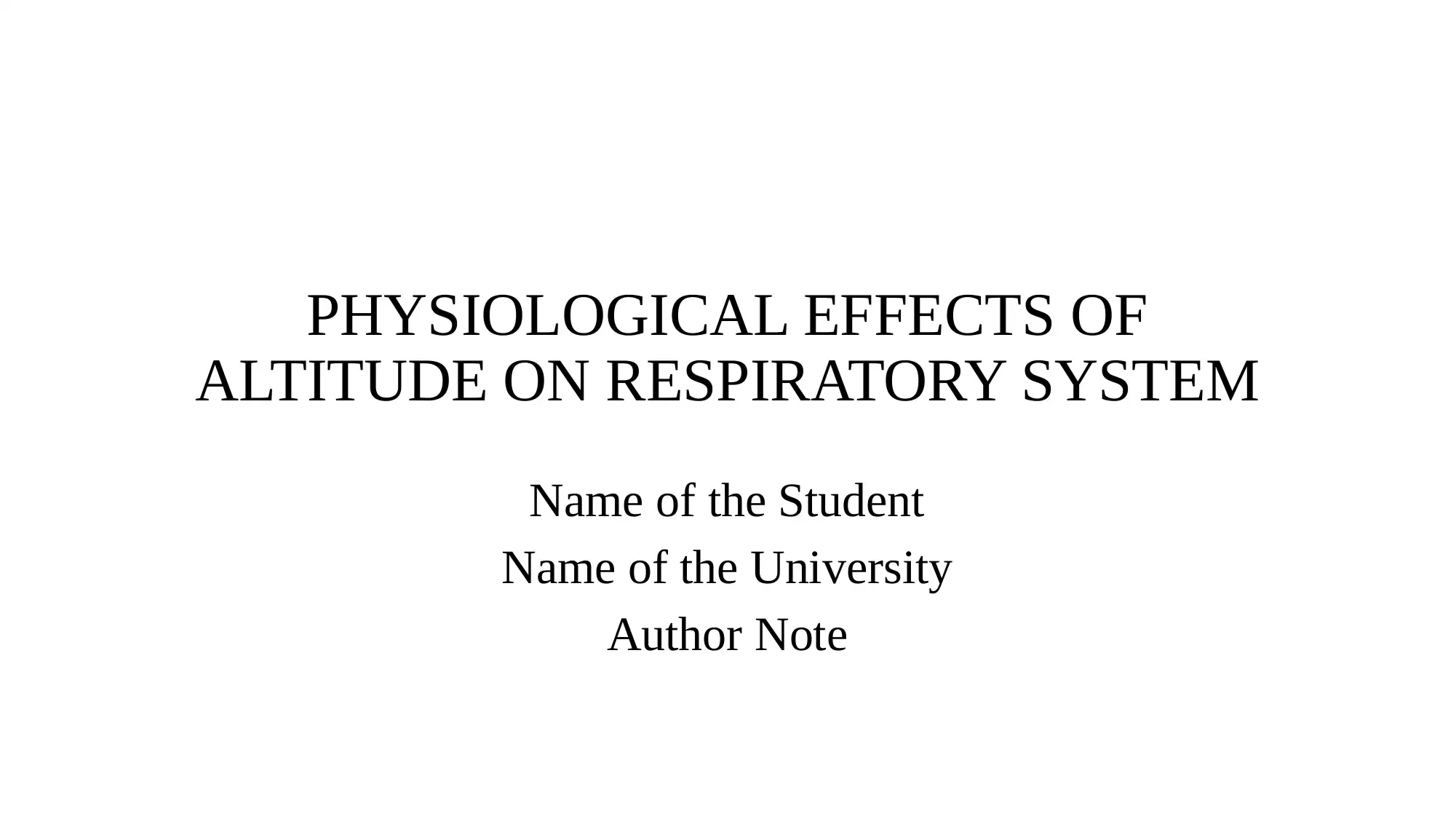
PHYSIOLOGICAL EFFECTS OF
ALTITUDE ON RESPIRATORY SYSTEM
Name of the Student
Name of the University
Author Note
ALTITUDE ON RESPIRATORY SYSTEM
Name of the Student
Name of the University
Author Note
Paraphrase This Document
Need a fresh take? Get an instant paraphrase of this document with our AI Paraphraser
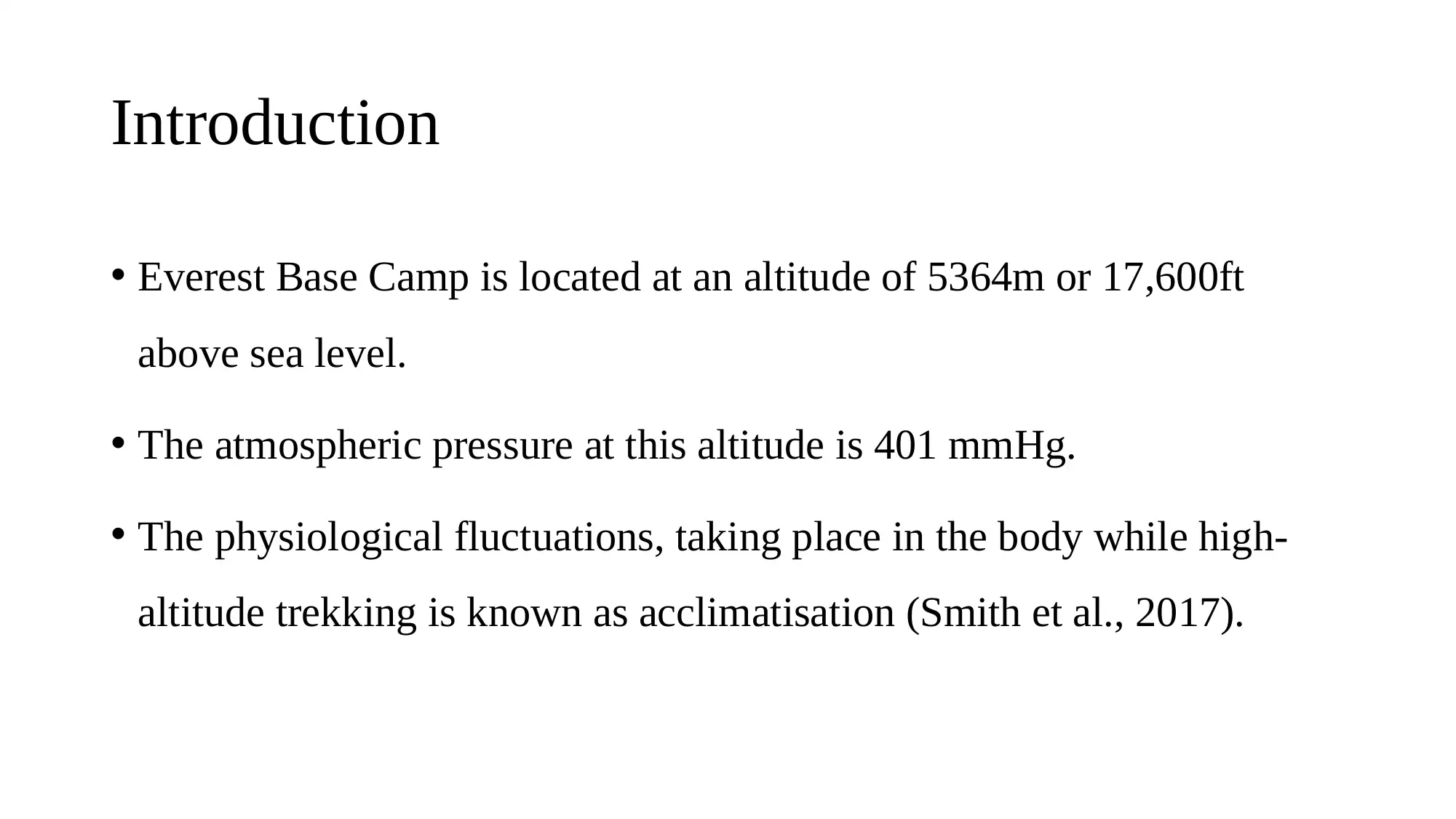
Introduction
• Everest Base Camp is located at an altitude of 5364m or 17,600ft
above sea level.
• The atmospheric pressure at this altitude is 401 mmHg.
• The physiological fluctuations, taking place in the body while high-
altitude trekking is known as acclimatisation (Smith et al., 2017).
• Everest Base Camp is located at an altitude of 5364m or 17,600ft
above sea level.
• The atmospheric pressure at this altitude is 401 mmHg.
• The physiological fluctuations, taking place in the body while high-
altitude trekking is known as acclimatisation (Smith et al., 2017).
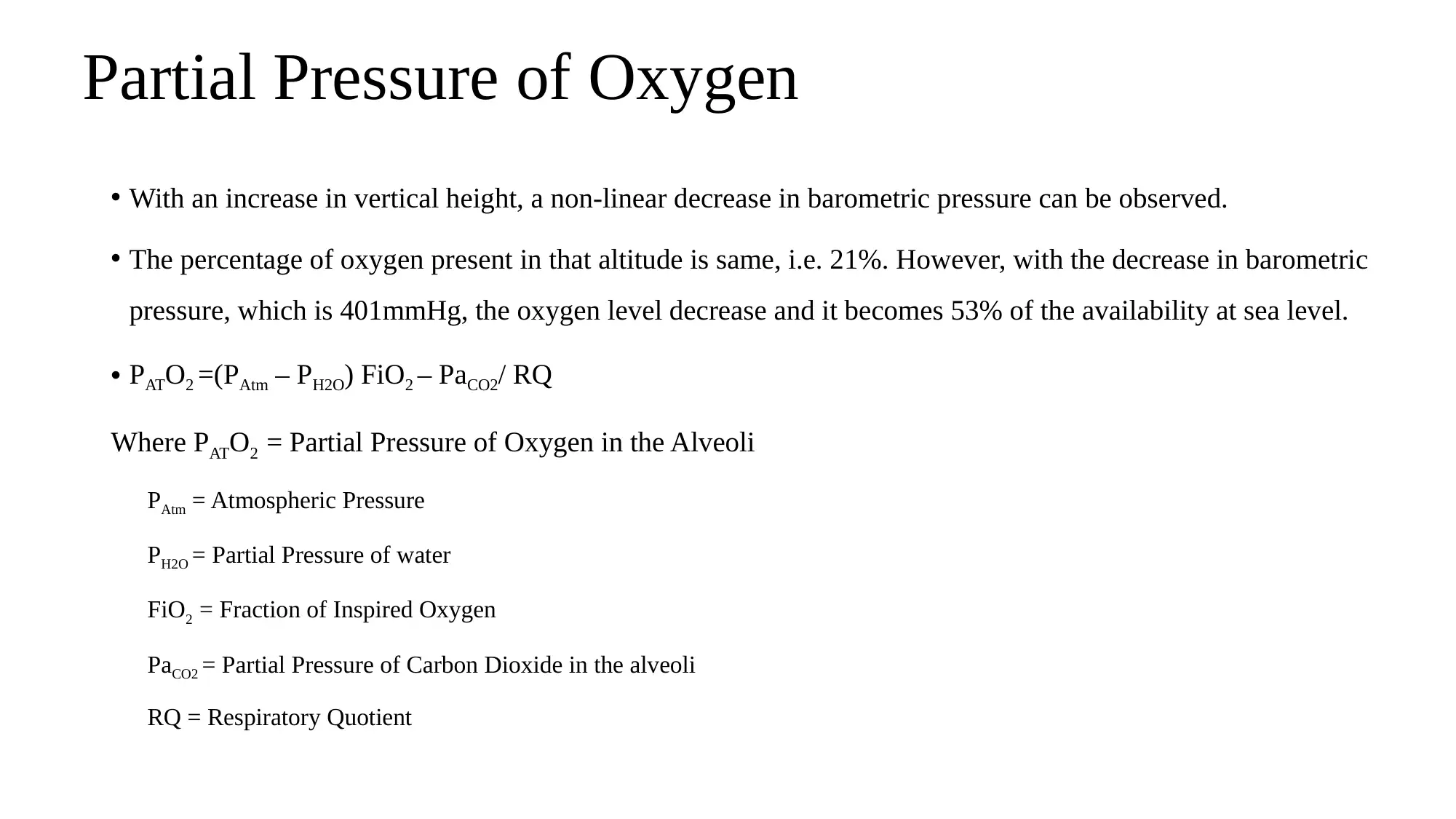
Partial Pressure of Oxygen
• With an increase in vertical height, a non-linear decrease in barometric pressure can be observed.
• The percentage of oxygen present in that altitude is same, i.e. 21%. However, with the decrease in barometric
pressure, which is 401mmHg, the oxygen level decrease and it becomes 53% of the availability at sea level.
• PATO2 =(PAtm – PH2O) FiO2 – PaCO2/ RQ
Where PATO2 = Partial Pressure of Oxygen in the Alveoli
PAtm = Atmospheric Pressure
PH2O = Partial Pressure of water
FiO2 = Fraction of Inspired Oxygen
PaCO2 = Partial Pressure of Carbon Dioxide in the alveoli
RQ = Respiratory Quotient
• With an increase in vertical height, a non-linear decrease in barometric pressure can be observed.
• The percentage of oxygen present in that altitude is same, i.e. 21%. However, with the decrease in barometric
pressure, which is 401mmHg, the oxygen level decrease and it becomes 53% of the availability at sea level.
• PATO2 =(PAtm – PH2O) FiO2 – PaCO2/ RQ
Where PATO2 = Partial Pressure of Oxygen in the Alveoli
PAtm = Atmospheric Pressure
PH2O = Partial Pressure of water
FiO2 = Fraction of Inspired Oxygen
PaCO2 = Partial Pressure of Carbon Dioxide in the alveoli
RQ = Respiratory Quotient
⊘ This is a preview!⊘
Do you want full access?
Subscribe today to unlock all pages.

Trusted by 1+ million students worldwide
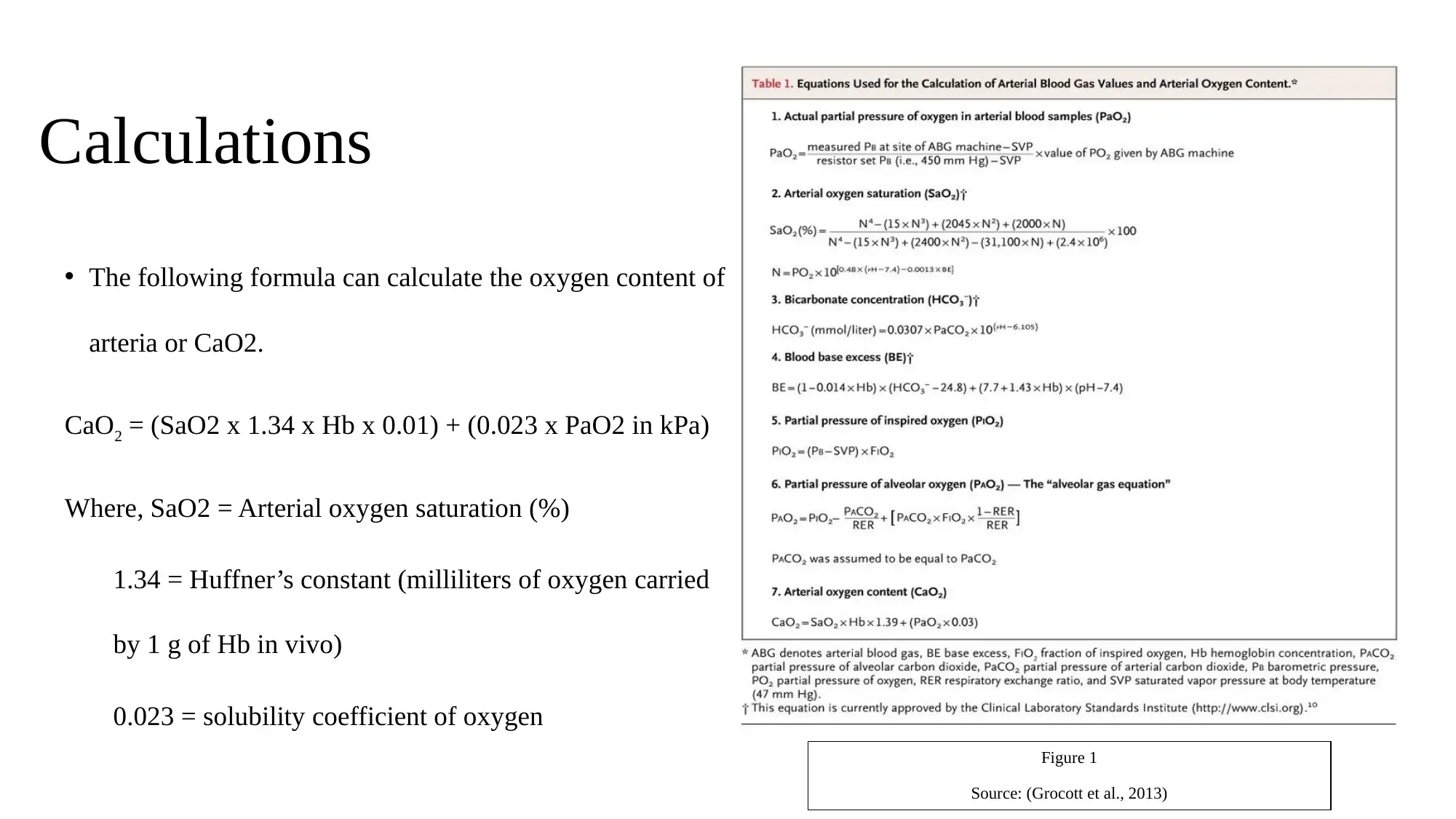
Figure 1
Source: (Grocott et al., 2013)
Calculations
• The following formula can calculate the oxygen content of
arteria or CaO2.
CaO2 = (SaO2 x 1.34 x Hb x 0.01) + (0.023 x PaO2 in kPa)
Where, SaO2 = Arterial oxygen saturation (%)
1.34 = Huffner’s constant (milliliters of oxygen carried
by 1 g of Hb in vivo)
0.023 = solubility coefficient of oxygen
Source: (Grocott et al., 2013)
Calculations
• The following formula can calculate the oxygen content of
arteria or CaO2.
CaO2 = (SaO2 x 1.34 x Hb x 0.01) + (0.023 x PaO2 in kPa)
Where, SaO2 = Arterial oxygen saturation (%)
1.34 = Huffner’s constant (milliliters of oxygen carried
by 1 g of Hb in vivo)
0.023 = solubility coefficient of oxygen
Paraphrase This Document
Need a fresh take? Get an instant paraphrase of this document with our AI Paraphraser

Partial Pressure and
Haemoglobin Saturation
• The mean partial arterial pressure of O2 at the altitude of
5300m is 50±3 mmHg.
• Haemoglobin saturation (SPO2) at this arterial pO2 is over
80% (Grocott et al., 2013).
• A central alkaline environment is produced when CO2 is
washed out due to delivery of cerebral oxygen in case of
arterial hypoxemia, stimulated by increased cerebral blood
flow (Sarkar, Niranjan & Banyal., 2017).
Figure 2: Oxy–hemoglobin dissociation curve
Source: (Baumstark et al., 2019)
Haemoglobin Saturation
• The mean partial arterial pressure of O2 at the altitude of
5300m is 50±3 mmHg.
• Haemoglobin saturation (SPO2) at this arterial pO2 is over
80% (Grocott et al., 2013).
• A central alkaline environment is produced when CO2 is
washed out due to delivery of cerebral oxygen in case of
arterial hypoxemia, stimulated by increased cerebral blood
flow (Sarkar, Niranjan & Banyal., 2017).
Figure 2: Oxy–hemoglobin dissociation curve
Source: (Baumstark et al., 2019)
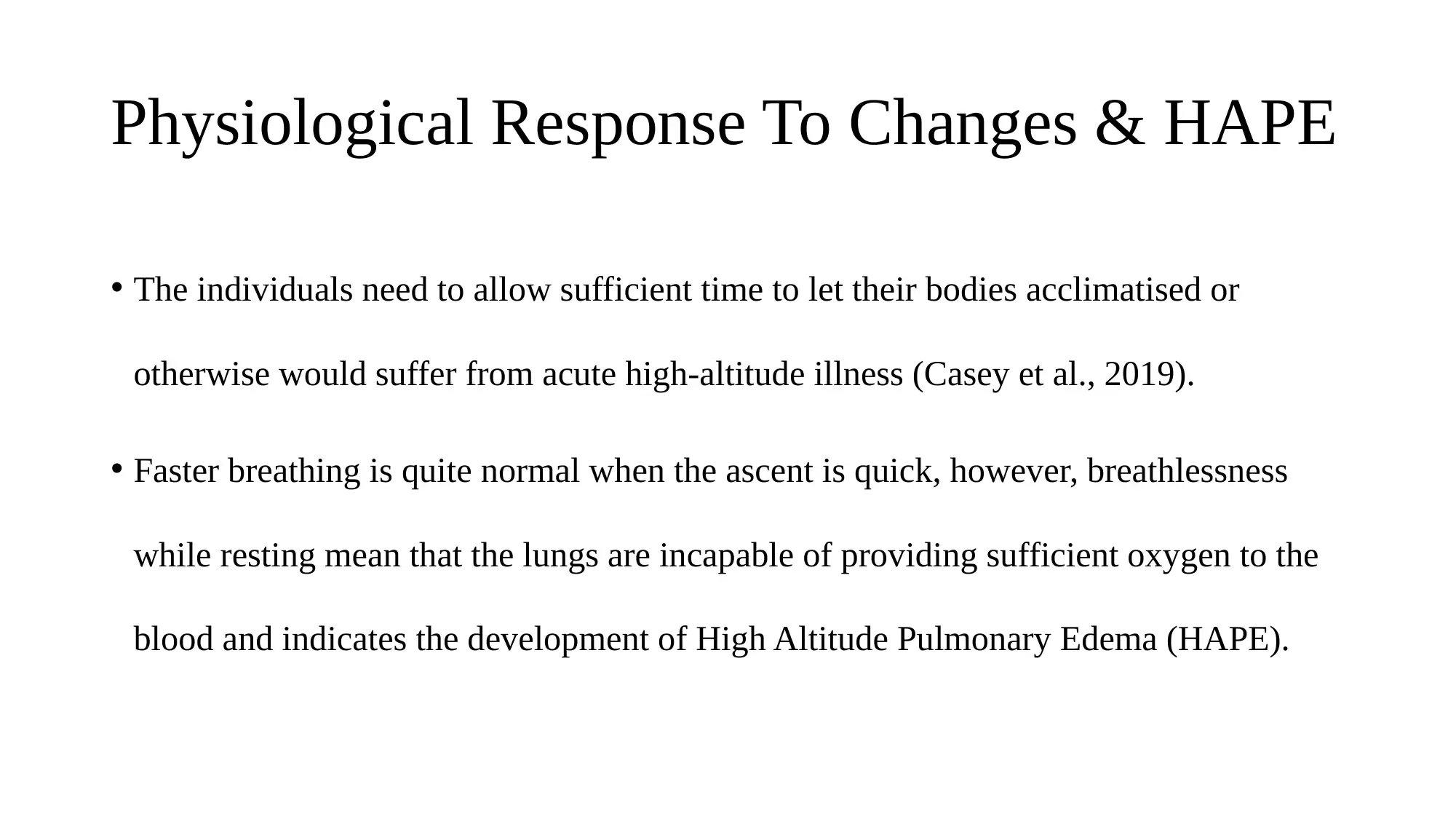
Physiological Response To Changes & HAPE
• The individuals need to allow sufficient time to let their bodies acclimatised or
otherwise would suffer from acute high-altitude illness (Casey et al., 2019).
• Faster breathing is quite normal when the ascent is quick, however, breathlessness
while resting mean that the lungs are incapable of providing sufficient oxygen to the
blood and indicates the development of High Altitude Pulmonary Edema (HAPE).
• The individuals need to allow sufficient time to let their bodies acclimatised or
otherwise would suffer from acute high-altitude illness (Casey et al., 2019).
• Faster breathing is quite normal when the ascent is quick, however, breathlessness
while resting mean that the lungs are incapable of providing sufficient oxygen to the
blood and indicates the development of High Altitude Pulmonary Edema (HAPE).
⊘ This is a preview!⊘
Do you want full access?
Subscribe today to unlock all pages.

Trusted by 1+ million students worldwide
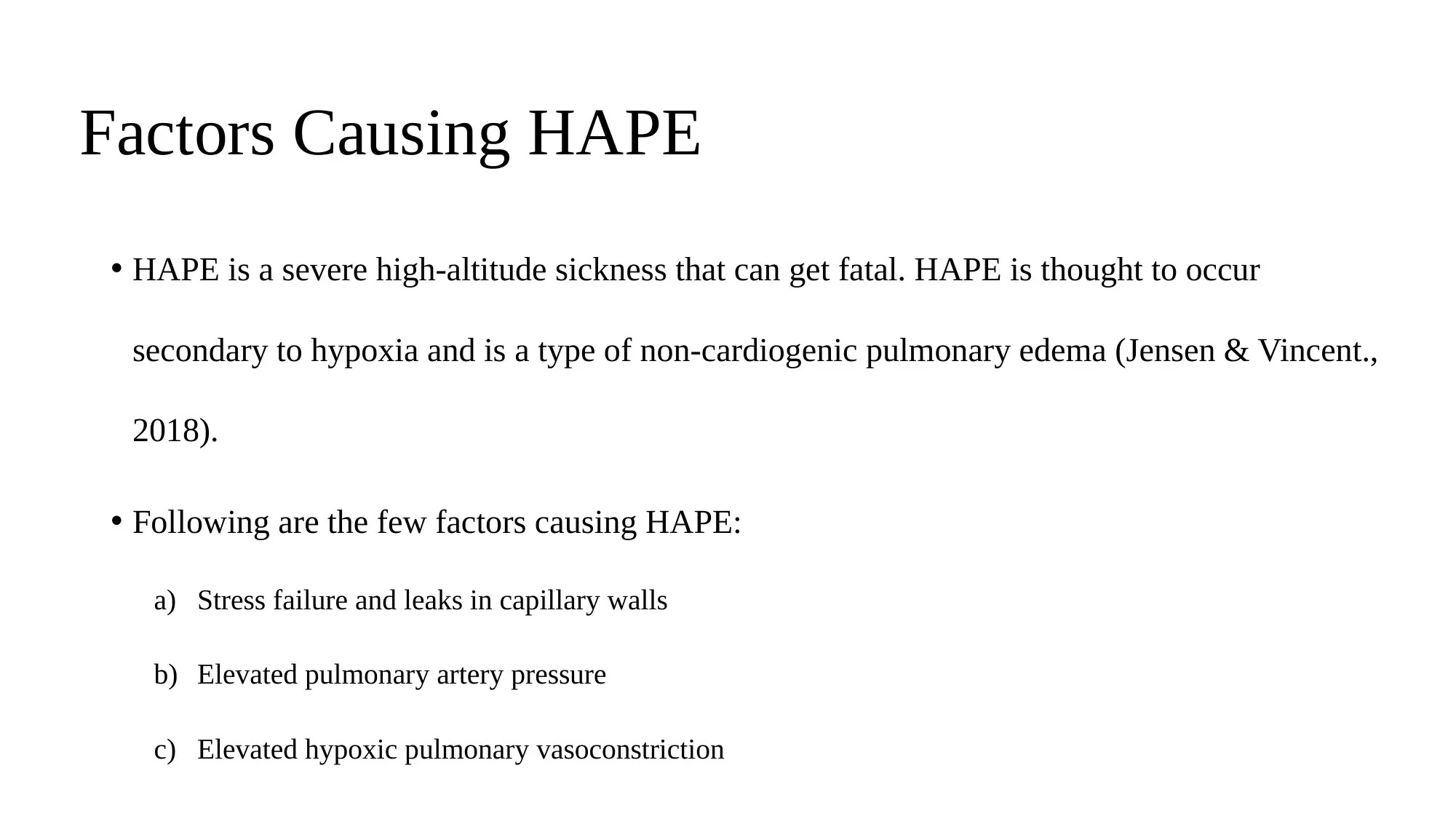
Factors Causing HAPE
• HAPE is a severe high-altitude sickness that can get fatal. HAPE is thought to occur
secondary to hypoxia and is a type of non-cardiogenic pulmonary edema (Jensen & Vincent.,
2018).
• Following are the few factors causing HAPE:
a) Stress failure and leaks in capillary walls
b) Elevated pulmonary artery pressure
c) Elevated hypoxic pulmonary vasoconstriction
• HAPE is a severe high-altitude sickness that can get fatal. HAPE is thought to occur
secondary to hypoxia and is a type of non-cardiogenic pulmonary edema (Jensen & Vincent.,
2018).
• Following are the few factors causing HAPE:
a) Stress failure and leaks in capillary walls
b) Elevated pulmonary artery pressure
c) Elevated hypoxic pulmonary vasoconstriction
Paraphrase This Document
Need a fresh take? Get an instant paraphrase of this document with our AI Paraphraser
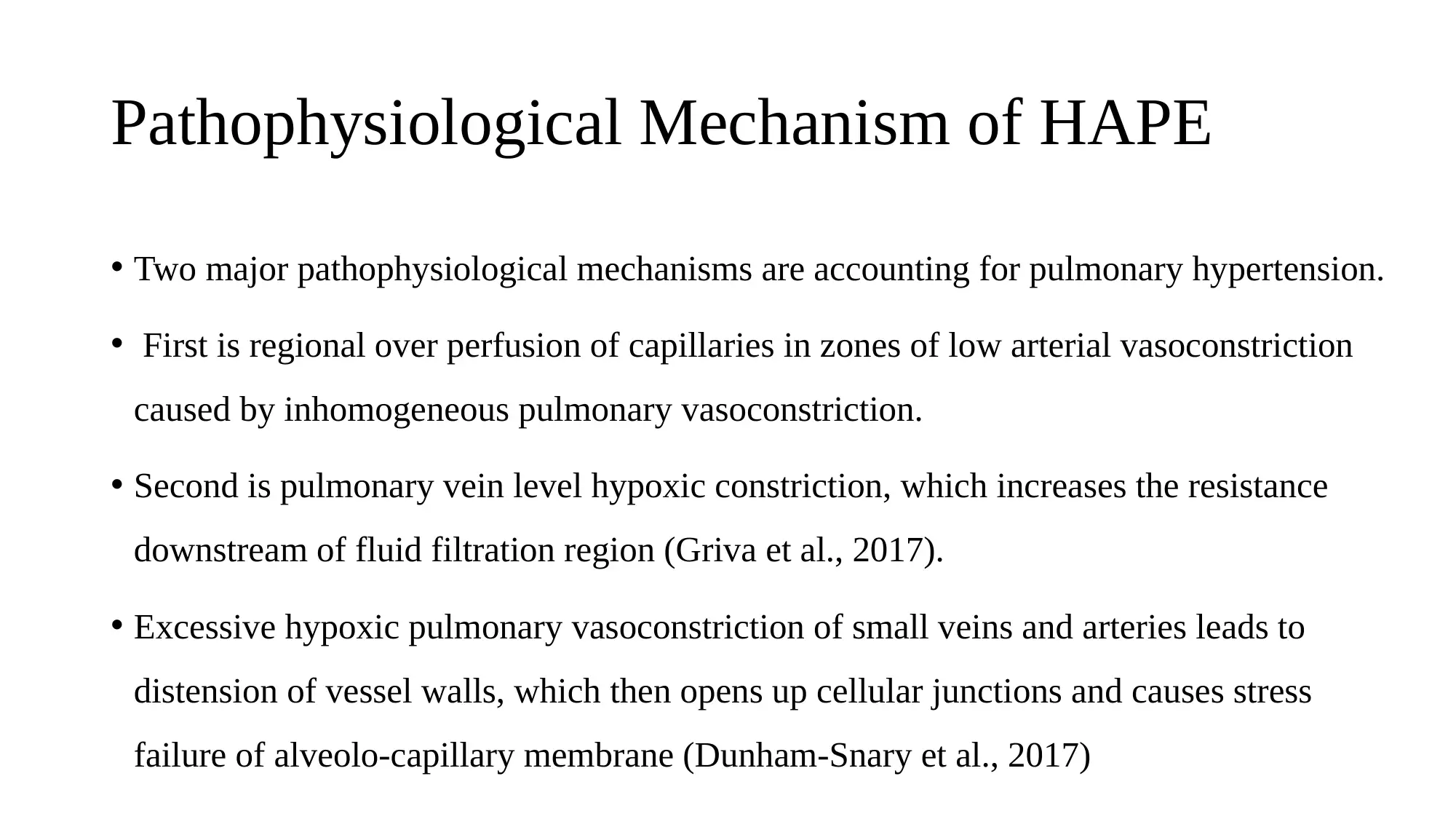
Pathophysiological Mechanism of HAPE
• Two major pathophysiological mechanisms are accounting for pulmonary hypertension.
• First is regional over perfusion of capillaries in zones of low arterial vasoconstriction
caused by inhomogeneous pulmonary vasoconstriction.
• Second is pulmonary vein level hypoxic constriction, which increases the resistance
downstream of fluid filtration region (Griva et al., 2017).
• Excessive hypoxic pulmonary vasoconstriction of small veins and arteries leads to
distension of vessel walls, which then opens up cellular junctions and causes stress
failure of alveolo-capillary membrane (Dunham-Snary et al., 2017)
• Two major pathophysiological mechanisms are accounting for pulmonary hypertension.
• First is regional over perfusion of capillaries in zones of low arterial vasoconstriction
caused by inhomogeneous pulmonary vasoconstriction.
• Second is pulmonary vein level hypoxic constriction, which increases the resistance
downstream of fluid filtration region (Griva et al., 2017).
• Excessive hypoxic pulmonary vasoconstriction of small veins and arteries leads to
distension of vessel walls, which then opens up cellular junctions and causes stress
failure of alveolo-capillary membrane (Dunham-Snary et al., 2017)

Signs of HAPE
• While travelling to high altitude, the body will first experience minute ventilation, which
results in respiratory alkalosis.
• After TBC 2,3-DPG levels start increasing, the Hgb-O2 dissociation curve shifts to the
right (decreased O2 affinity by hemoglobin) (Baumstark et al., 2019). This allows the
stressed tissues (due to trekking) to get more oxygen.
• The various signs that the trekkers should look out for are shortness of breath while at rest,
dyspnea, clammy skin, blue-tinged lips, a blood-tinged cough that has frothy sputum and
palpitations.
• While travelling to high altitude, the body will first experience minute ventilation, which
results in respiratory alkalosis.
• After TBC 2,3-DPG levels start increasing, the Hgb-O2 dissociation curve shifts to the
right (decreased O2 affinity by hemoglobin) (Baumstark et al., 2019). This allows the
stressed tissues (due to trekking) to get more oxygen.
• The various signs that the trekkers should look out for are shortness of breath while at rest,
dyspnea, clammy skin, blue-tinged lips, a blood-tinged cough that has frothy sputum and
palpitations.
⊘ This is a preview!⊘
Do you want full access?
Subscribe today to unlock all pages.

Trusted by 1+ million students worldwide
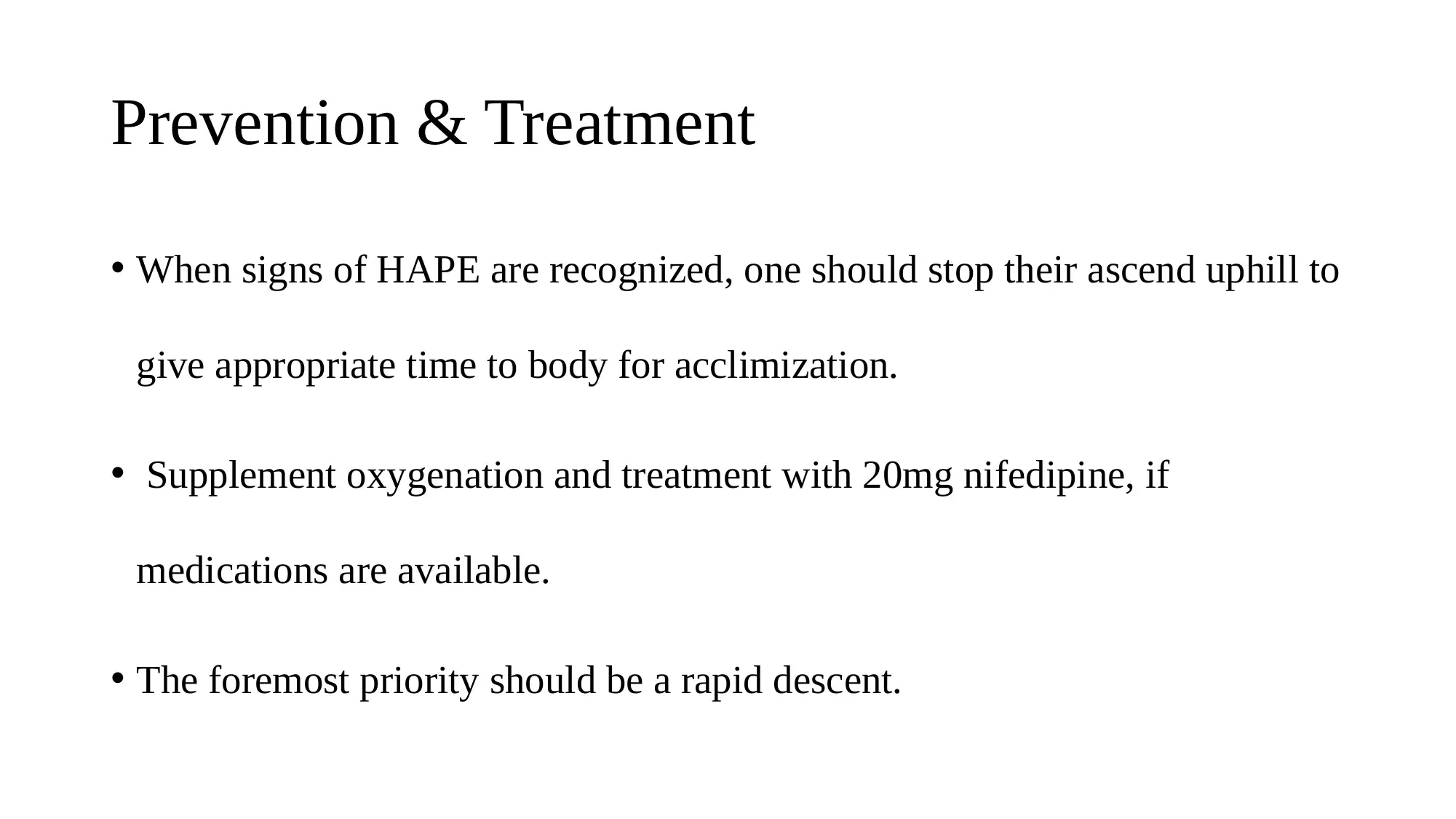
Prevention & Treatment
• When signs of HAPE are recognized, one should stop their ascend uphill to
give appropriate time to body for acclimization.
• Supplement oxygenation and treatment with 20mg nifedipine, if
medications are available.
• The foremost priority should be a rapid descent.
• When signs of HAPE are recognized, one should stop their ascend uphill to
give appropriate time to body for acclimization.
• Supplement oxygenation and treatment with 20mg nifedipine, if
medications are available.
• The foremost priority should be a rapid descent.
Paraphrase This Document
Need a fresh take? Get an instant paraphrase of this document with our AI Paraphraser
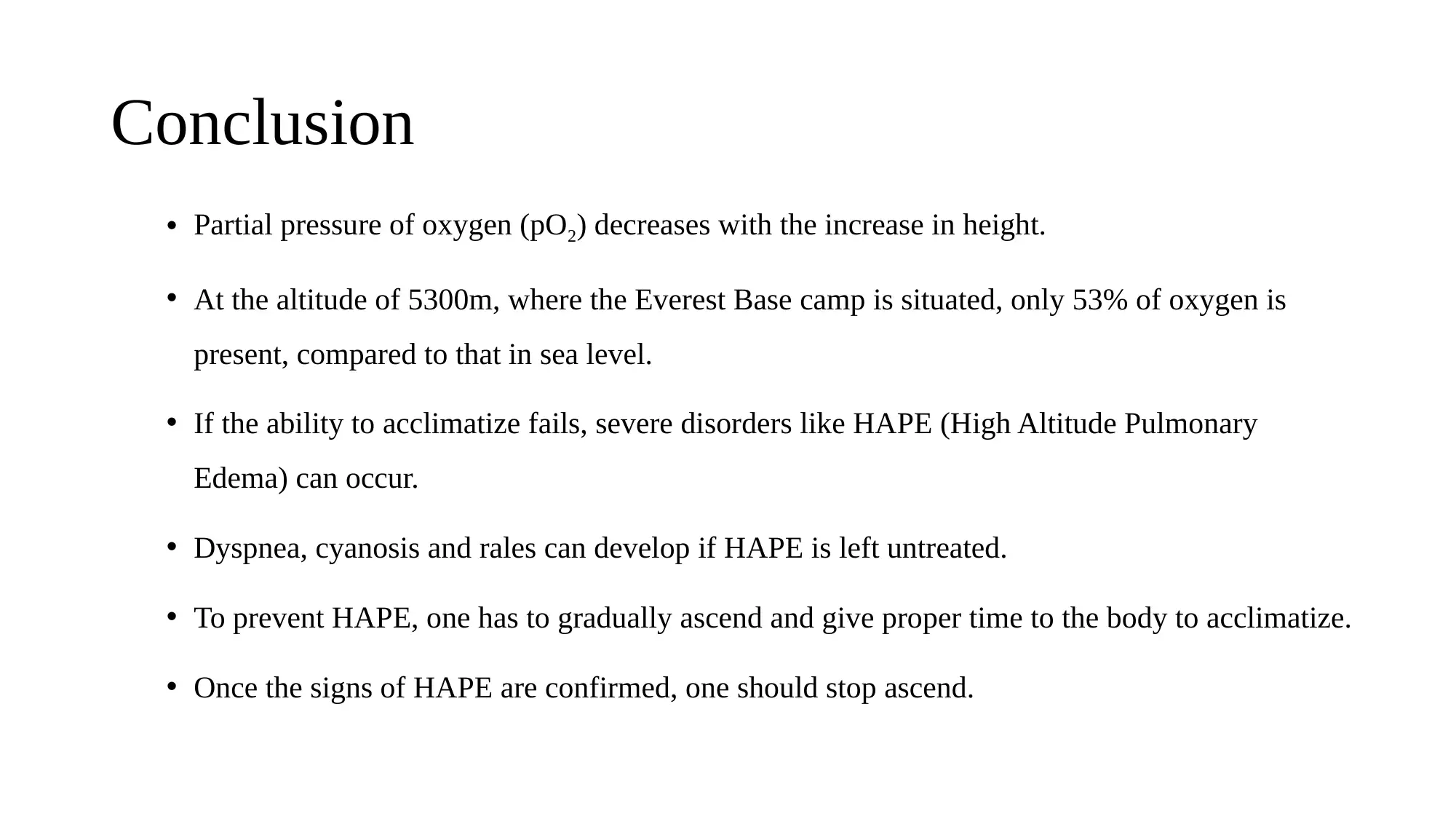
Conclusion
• Partial pressure of oxygen (pO2) decreases with the increase in height.
• At the altitude of 5300m, where the Everest Base camp is situated, only 53% of oxygen is
present, compared to that in sea level.
• If the ability to acclimatize fails, severe disorders like HAPE (High Altitude Pulmonary
Edema) can occur.
• Dyspnea, cyanosis and rales can develop if HAPE is left untreated.
• To prevent HAPE, one has to gradually ascend and give proper time to the body to acclimatize.
• Once the signs of HAPE are confirmed, one should stop ascend.
• Partial pressure of oxygen (pO2) decreases with the increase in height.
• At the altitude of 5300m, where the Everest Base camp is situated, only 53% of oxygen is
present, compared to that in sea level.
• If the ability to acclimatize fails, severe disorders like HAPE (High Altitude Pulmonary
Edema) can occur.
• Dyspnea, cyanosis and rales can develop if HAPE is left untreated.
• To prevent HAPE, one has to gradually ascend and give proper time to the body to acclimatize.
• Once the signs of HAPE are confirmed, one should stop ascend.
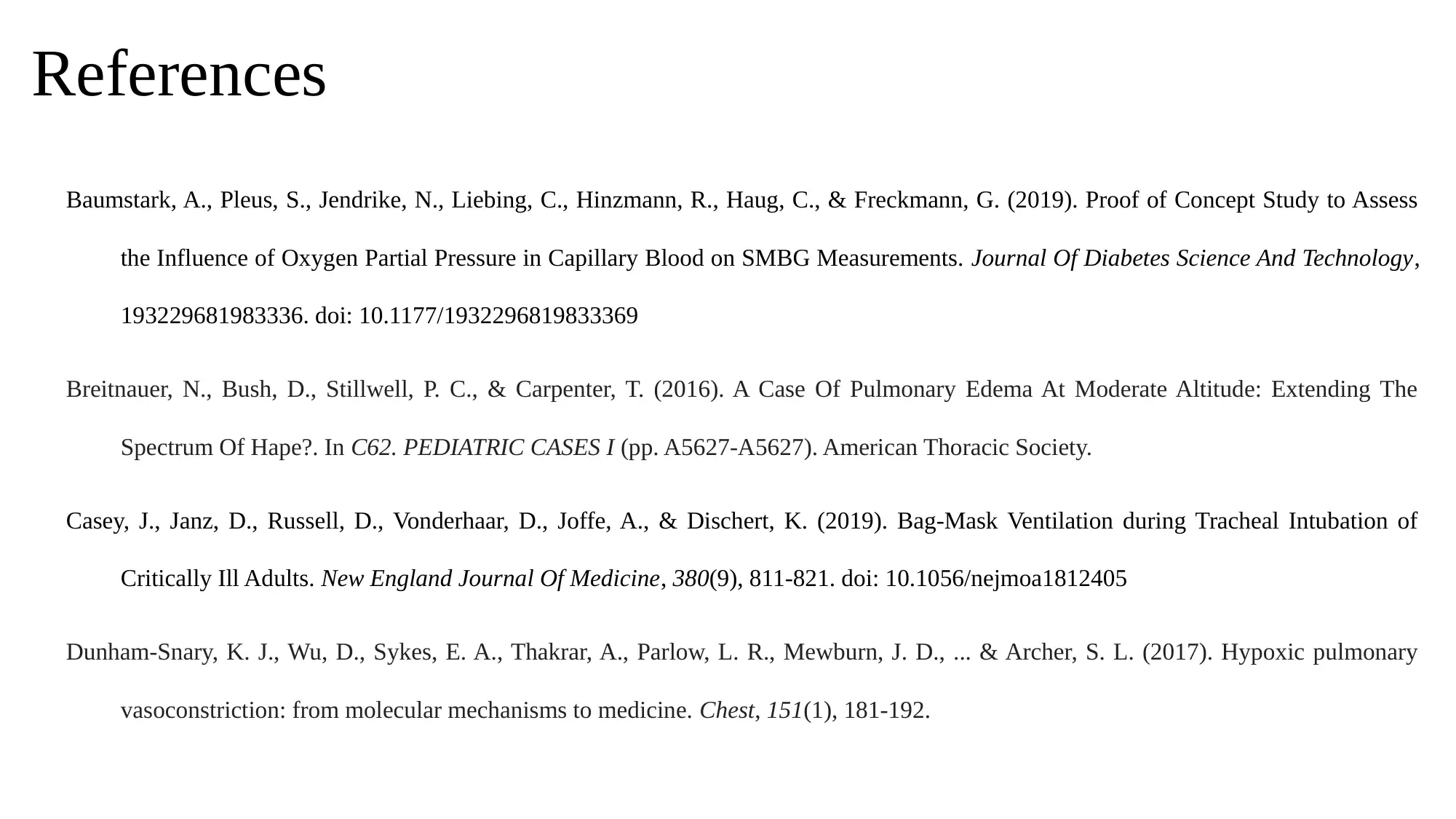
References
Baumstark, A., Pleus, S., Jendrike, N., Liebing, C., Hinzmann, R., Haug, C., & Freckmann, G. (2019). Proof of Concept Study to Assess
the Influence of Oxygen Partial Pressure in Capillary Blood on SMBG Measurements. Journal Of Diabetes Science And Technology,
193229681983336. doi: 10.1177/1932296819833369
Breitnauer, N., Bush, D., Stillwell, P. C., & Carpenter, T. (2016). A Case Of Pulmonary Edema At Moderate Altitude: Extending The
Spectrum Of Hape?. In C62. PEDIATRIC CASES I (pp. A5627-A5627). American Thoracic Society.
Casey, J., Janz, D., Russell, D., Vonderhaar, D., Joffe, A., & Dischert, K. (2019). Bag-Mask Ventilation during Tracheal Intubation of
Critically Ill Adults. New England Journal Of Medicine, 380(9), 811-821. doi: 10.1056/nejmoa1812405
Dunham-Snary, K. J., Wu, D., Sykes, E. A., Thakrar, A., Parlow, L. R., Mewburn, J. D., ... & Archer, S. L. (2017). Hypoxic pulmonary
vasoconstriction: from molecular mechanisms to medicine. Chest, 151(1), 181-192.
Baumstark, A., Pleus, S., Jendrike, N., Liebing, C., Hinzmann, R., Haug, C., & Freckmann, G. (2019). Proof of Concept Study to Assess
the Influence of Oxygen Partial Pressure in Capillary Blood on SMBG Measurements. Journal Of Diabetes Science And Technology,
193229681983336. doi: 10.1177/1932296819833369
Breitnauer, N., Bush, D., Stillwell, P. C., & Carpenter, T. (2016). A Case Of Pulmonary Edema At Moderate Altitude: Extending The
Spectrum Of Hape?. In C62. PEDIATRIC CASES I (pp. A5627-A5627). American Thoracic Society.
Casey, J., Janz, D., Russell, D., Vonderhaar, D., Joffe, A., & Dischert, K. (2019). Bag-Mask Ventilation during Tracheal Intubation of
Critically Ill Adults. New England Journal Of Medicine, 380(9), 811-821. doi: 10.1056/nejmoa1812405
Dunham-Snary, K. J., Wu, D., Sykes, E. A., Thakrar, A., Parlow, L. R., Mewburn, J. D., ... & Archer, S. L. (2017). Hypoxic pulmonary
vasoconstriction: from molecular mechanisms to medicine. Chest, 151(1), 181-192.
⊘ This is a preview!⊘
Do you want full access?
Subscribe today to unlock all pages.

Trusted by 1+ million students worldwide
1 out of 13
Your All-in-One AI-Powered Toolkit for Academic Success.
+13062052269
info@desklib.com
Available 24*7 on WhatsApp / Email
![[object Object]](/_next/static/media/star-bottom.7253800d.svg)
Unlock your academic potential
Copyright © 2020–2025 A2Z Services. All Rights Reserved. Developed and managed by ZUCOL.
